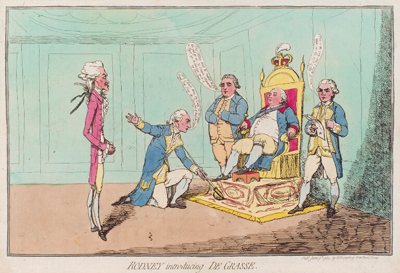Rodney Introducing De Grasse
One of four prints in as many weeks about the stunning naval victory of Admiral George Rodney over the Comte de Grasse at the Battle of the Saintes in the West Indies. The result was an unpleasant surprise for Fox, Keppel, and the new Whig Ministry who had sent word to recall Rodney and replace him with Admiral Hugh Pigot before they heard the news of Rodney's triumph. This is the first of two prints created for Hannah Humphrey on the subject. The other two Rodney prints were published by Elizabeth D'Archery.

© National Portrait Gallery, London
Though the print appears like it could have been based on a real event, either past or projected, it is like the other Rodney prints more symbolic than real. De Grasse did not arrive in London as a prisoner of war until August 3, 1782 nearly two months after this print was published. He returned to France on August 12th. And there is nothing I have found in the newspapers of the time to suggest that he was ever "introduced" to the King.
Instead the print mostly repeats elements and suggestions found in the two previous Gillray satires, Rodney Triumphant. . . (May 31, 1782) and Rodney Invested. . . (June 4, 1782).
One is the suggestion that the new Minister for Foreign Affairs, Charles James Fox, shown appropriately standing between Rodney and the King, nominated his old friend and gambling buddy, Admiral Hugh Pigot, to replace Rodney in order to insure that Pigot could repay a debt of £17,000 he had accumulated at Fox's Faro table.
Another involves the new First Lord of the Admiralty, Augustus Keppel, shown on the other side of the King, who had mismanaged his forces at the Battle of Ushant on April 27, 1778 enabling numerous French vessels to escape unscathed, among them the flagship Ville de Paris which had now been captured by Rodney.
As in the two previous prints, Rodney is heroic and idealized in keeping with the national mood which heralded him as the greatest British admiral at that time. De Grasse is once again a crude parody of a Frenchman, similar to the image Gillray had been using at least since National Discourse, absurdly thin and foppish, in no way resmbling his actual figure.
What is new in the print is the implicit crtiticism of the King who has allowed himself to be misled by his new ministers, Fox and Keppel, and complicit in the recall of Rodney. George III is shown asleep on his throne seemingly oblivious to Rodney's efforts on his behalf. This was not the first time Gillray had accused the King of being asleep on the job. In Argus (1780) he had also shown a dozing King at the mercy of designing ministers.
Sources and Reading
- Commentary from the British Museum on Rodney Introducing De Grasse
- "George Brydges Rodney, 1st Baron Rodney," Wikipedia
- "François Joseph Paul de Grasse," Wikipedia
- "Battle of the Saintes," Wikipedia
- "Augustus Keppel, 1st Viscount Keppel," Wikipedia
- "Battle of Ushant (1778)," Wikipedia
- Thomas Wright and R.H. Evans, Historical and Descriptive Account of the Caricatures of James Gillray #3
Comments & Corrections
NOTE: Comments and/or corrections are always appreciated. To make that easier, I have included a form below that you can use. I promise never to share any of the info provided without your express permission.